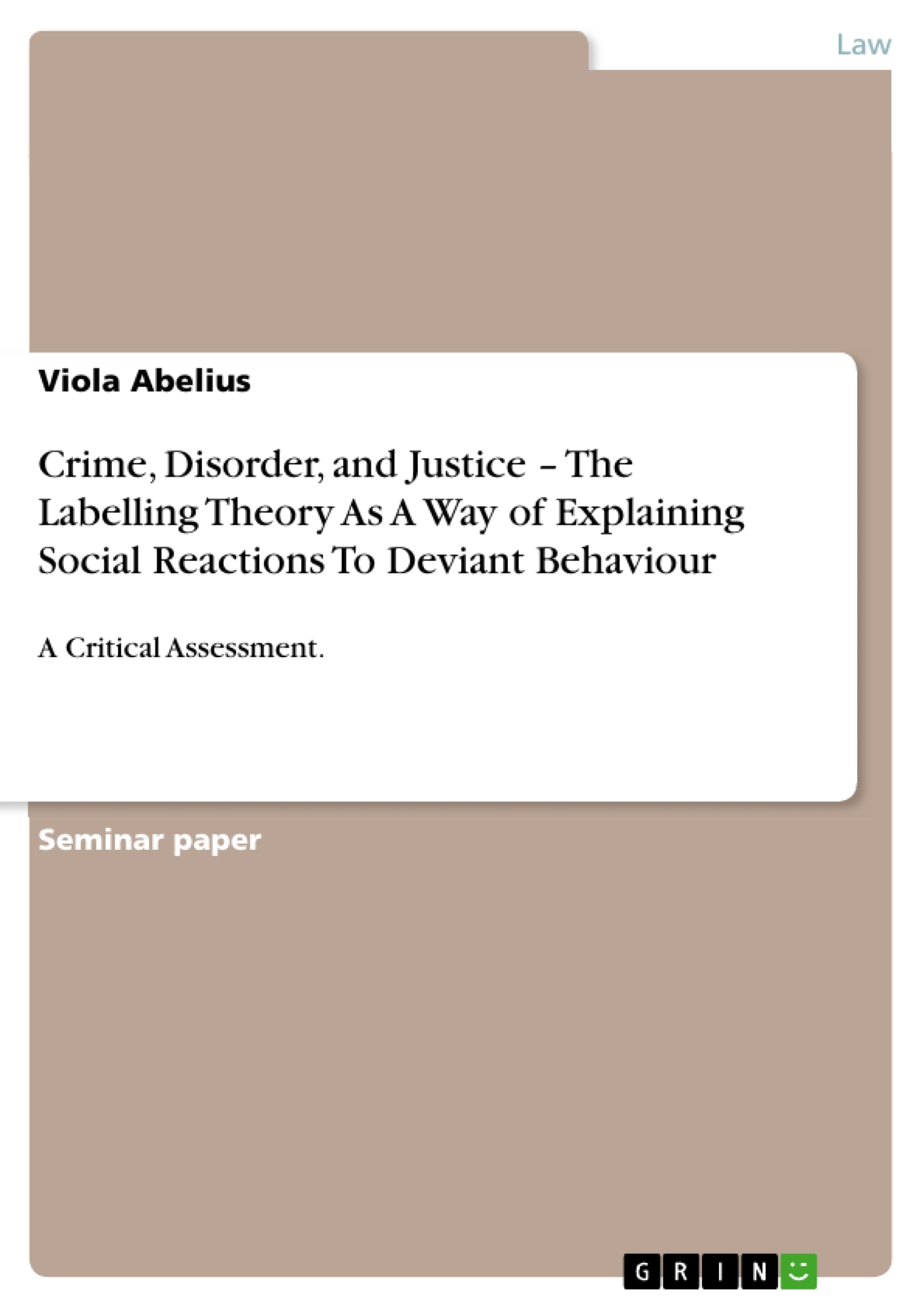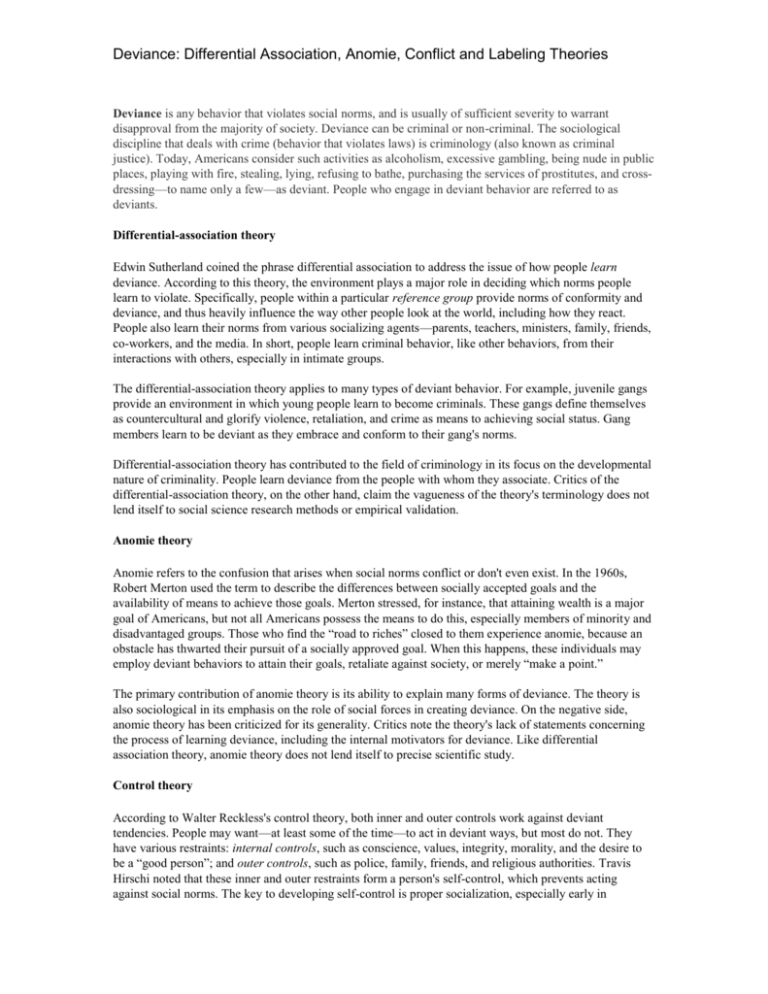Best Theroy That Describes Pathway to Dviance
Labeling According to __________ people who encounter barriers to social goals exhibit four types of deviant behavior. People who choose this path reject both the cultural goals and the institutionalized means of reaching them.

Biological Theories Of Crime 1 Main Assumptions 2 Lombroso 3 Sheldon 4 Xyy Male Theories Of Crime Studying Law Crime
Theoretical Perspectives on Deviance.
. Functionalism symbolic interactionism and conflict theory. This administration worker is uninterested in doing quality work and the only sole is. Hence deviance varies depending upon the culture and the legal system and society of that culture.
Theories on deviance include the position that deviance is due to cultural transmissions it is learned structural strains the deviant individual is not conforming to others around him as he should or labeling society chooses what is labeled deviant but that act. American sociologist Robert K. Deviance can mean breaking one norm to place another before it which is a fundamental insight of social strain typology.
A woman working on the admission desk in the public office is responsible for all mail and another submission and her job is to receive those submissions to record them under a certain code that best describes the content of the letter and where next should that submission be forwarded. According to the cognitive development theory criminal and deviant behavior results from the way in which individuals organize their thoughts around morality and the law. Innovation ritualism retreatism and rebellion.
Good grades The removal of positive impulses eg. Functionalism symbolic interactionism and conflict theory. Conflict Theory views deviant behavior as a consequence of material inequality between various socio-political groups.
How Cognitive Development Theory Explains Deviance. Define how critical sociology understands the relationship between deviance crime and class inequality. Advance care planning ACP has been identified as particularly relevant for nursing home residents but it remains unclear how or under what circumstances ACP works and can best be implemented in such settings.
American sociologist Robert Mertons theory of anomie holds that deviance is often a response to situations in which goals cannot be achieved through conventional behaviour. Lets revisit marijuana legalization from a theoretical perspective. With examples which of the theory of deviance best explains deviant behavior.
Those groups might be drawn along the lines of gender religion race class and so on. Ex people who drop out of goals through alcohol and drugs. We started the year 2020 as an analog society.
This path suggests that individuals could alleviate the strain by changing their cultural goals and by withdrawing allegiance to the institutionalised means. These theories can be grouped according to the three major sociological paradigms. To Merton anomie was a condition that existed in the discrepancy between societal goals and the means that individuals have in achieving them.
Since the early days of sociology scholars have developed theories that attempt to explain what deviance and crime mean to society. Overview of Robert Mertons Theory of Deviance. The intimacy deficit pathway describes an offender who takes advantage of an opportunity to offend if a preferred sexual partner is not available.
Robert Merton who lived from 1910-2003 argued that society may be set up in a way that encourages too much devianceMerton believed that when societal norms or. Pathway to deviance that begins at an early age with stubborn behavior and leads to defiance and then to authority avoidance Covert Pathway pathway to a criminal career that begins with minor underhanded behaviors leads to property damage and eventually escalates to more serious forms of theft and fraud. Rebellion reject societys goals and institutionalized means the seek to give society new goals.
Merton developed structural strain theory as an extension of the functionalist perspective on deviance. Answer 1 of 2. What changes are expected by.
Lawrence Kohlberg a developmental psychologist theorized that there are three levels of moral reasoningDuring the. Merton considered this path to. Merton asserted that societies are composed of two core aspects.
This theory traces the origins of deviance to the tensions that are caused by the gap between cultural goals and. Building off of Durkheims work on anomie Merton 1957 was the first person to write about what sociologists call strain theory. The first path is Conformity.
The theory primarily pertains to formal deviance using biological reasons to explain criminality though it can certainly extend to informal deviance. In democratic societies people from wealthy highly connected and privileged circumstances have relatively easy routes to personal success and prosperity. Describe the functionalist view of deviance in society including social disorganization theory control theory and strain theory.
Cesare Lombroso A biological interpretation of formal deviance was first advanced by the Italian School of Criminology a school of thought originating from Italy during the mid-nineteenth century. Merton developed strain theory a concept connected to both the functionalist perspective on deviance and Émile Durkheims theory of anomie. _____ theory focuses on how reputations can either set us on a path to deviance or divert us away from it.
According to Agnew there are three main reasons for deviance-producing strain. We aimed to develop a theory that outlines the hypothetical causal pathway of ACP in nursing homes ie. Culture and social structure.
When one who thinks observes norms of society he tends to notice that which the programmed do not. Although structuralist theories had enormous impact on sociologists thinking about deviance others emerged who felt that these were not all-encompassing explanations. Robert Mertons theory that says that deviance is most likely to occur when there is a discrepancy between a culturally prescribed goal and a legitimate means of obtaining it conformity innovation ritualism retreatism and rebellion.
These theorists believed that deviance was a collective act driven and carried out by groups of people. This offender has significant problems with intimacy and turns to sex to ease feelings of loneliness. These theories can be grouped according to the three major sociological paradigms.
The failure to achieve a goal eg. A pathway to deviance that begins at an early age with stubborn behavior and leads to property damage and eventually escalates to more serious forms. Building on conflict theorys view that mul-.
The second path is Retreatism. Since the early days of sociology scholars have developed theories that attempt to explain what deviance and crime mean to society. Death of a parent end of relationship.
Compared to Mertons explanations of anomie theory the General Strain Theory provides a broader view of the causes of stress. Our values beliefs goals and identities are developed in the.

Interesting Sociology Research Topics In Ireland Sociology What Is Sociology Sociology Theory
A Theory Of Migration Everett S Lee 1996 Download Scientific Diagram

A Handy Myth Busting Guide To Uk Crime Statistics Ally Fogg Crime Road Closure Accident At Work

The Social Construction Of Reality A Treatise In The Sociology Of Knowledge Nook Book Sociology Books Sociology Reality

Sociology Careers Sociology Sociology Major

Sociology Vs Psychology Which Degree Is Right For Me Psychology Studies Psychology Notes Sociology

12 Jobs For Sociology Majors The University Network Sociology Sociology Major Sociology Careers

Crime Disorder And Justice The Labelling Theory As A Way Of Explaining Social Reactions To Deviant Behaviour Grin

Theories Of Crime Criminology Criminology Theories Of Crime Forensic Psychology

Norms Laws And Driving While Deviant Matty Chuah Sociological Cinema Sociology Driving Social Science

Crime And Deviance Complete Revision Sociology Crime Criminal Psychology

Pdf Revisiting Merton Continuities In The Theory Of Anomie And Opportunity Structures

Self Identity Personal Identity Identity Personal Achievements






Comments
Post a Comment